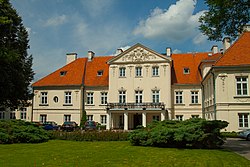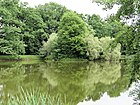world.wikisort.org - Poland
Leszno [ˈlɛʂnɔ] is a village in Warsaw West County, Masovian Voivodeship, in east-central Poland. It is the seat of the gmina (administrative district) called Gmina Leszno.[1] It lies approximately 15 kilometres (9 mi) west of Ożarów Mazowiecki and 28 km (17 mi) west of Warsaw.
Leszno | |
|---|---|
Village | |
 Łuszczewski Palace in Leszno | |
 Coat of arms | |
 Leszno  Leszno | |
| Coordinates: 52°16′N 20°36′E | |
| Country | |
| Voivodeship | Masovian |
| County | Warsaw West |
| Gmina | Leszno |
| Population | 3,500 |
| Time zone | UTC+1 (CET) |
| • Summer (DST) | UTC+2 (CEST) |
| Vehicle registration | WZ |
| Primary airport | Warsaw Chopin Airport |
| Website | http://www.gminaleszno.pl/ |
The village has a population of 3,500.
Polish professional footballer Robert Lewandowski grew up in Leszno.[2] In 2016 he became an honorary citizen of Leszno.[2]
History
The history of Leszno dates back to the Middle Ages. It was mentioned in documents in 1423.[3] It was owned by various families, including the Łuszczewski family, which built a Baroque palace, which is the main landmark of the village.[3]
Several men from Leszno died in various battles against the invading Russians during the Polish–Soviet War of 1919–1920.[4] A memorial to those soldiers is located in the local Catholic Church of Saint John the Baptist.[4]
During the invasion of Poland, which started World War II, in early September 1939, the Germans captured Leszno.[5] On September 16, Poles recaptured the village for tactical purposes, while the Germans retreated in panic.[5] On September 17, the Germans occupied Leszno again, and carried out a massacre of around 50 inhabitants in an act of revenge.[6] Many men were transported to Błonie, from where they were to be deported to forced labor to Germany, but some managed to escape.[5] About 70% of the village was burned down.[5]
Sights
The main landmark of Leszno is the Baroque Łuszczewski Palace with an adjacent park. There are two historic churches, one Catholic and one Mariavite. In the village there is also a monument commemorating Polish soldiers, partisans and inhabitants killed during World War II.[3]
Sports
The local football club is Partyzant Leszno. Robert Lewandowski took his first steps in football in the club. It competes in the lower leagues.
Gallery
- Architectural decorations on the facade of the Łuszczewski Palace
- Park
- Saint John the Baptist church
- Gmina office
References
- "Central Statistical Office (GUS) - TERYT (National Register of Territorial Land Apportionment Journal)" (in Polish). 2008-06-01.
- "Robert Lewandowski honorowym obywatelem Leszna". ZachodnieMazowsze.info (in Polish). Retrieved 8 May 2020.
- "Wieś Leszno". Szlaki turystyczne Mazowsza (in Polish). Retrieved 8 May 2020.
- Kowalski, Andrzej (1995). "Miejsca pamięci związane z Bitwą Warszawską 1920 r.". Niepodległość i Pamięć (in Polish). Muzeum Niepodległości w Warszawie (2/2 (3)): 139. ISSN 1427-1443.
- "79. rocznica spalenia Leszna". Stowarzyszenie Aktywne Leszno (in Polish). Retrieved 8 May 2020.
- Wardzyńska, Maria (2009). Był rok 1939. Operacja niemieckiej policji bezpieczeństwa w Polsce. Intelligenzaktion (in Polish). Warszawa: IPN. p. 97.
На других языках
[de] Leszno-Julinek
Leszno-Julinek ist ein Schulzenamt (polnisch sołectwo) der Landgemeinde Leszno im Powiat Warszawski Zachodni (Warschau West) der Woiwodschaft Masowien in Polen. Es besteht aus dem Ort Leszno und der Siedlung Julinek.- [en] Leszno, Warsaw West County
[fr] Leszno (Varsovie-ouest)
Leszno [ˈlɛʂnɔ] est un village polonais, situé dans la Powiat de Varsovie-ouest et dans la voïvodie de Mazovie dans le centre-est de la Pologne.Другой контент может иметь иную лицензию. Перед использованием материалов сайта WikiSort.org внимательно изучите правила лицензирования конкретных элементов наполнения сайта.
WikiSort.org - проект по пересортировке и дополнению контента Википедии




